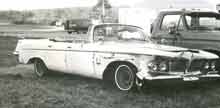I Love a Parade
Doesn't everyone? Of course, a parade must have marching bands, baton twirlers, fire engines and celebrities riding in parade phaetons. What kind of parade phaetons? Well, didn't Chrysler build the best parade phaetons?
One of the best known is "Famous Fanny," a Crown Imperial built by Derham Body Company of Rosemont, Pennsylvania for New York City in 1940. In this photo, General Eisenhower receives a hero's welcome from New Yorkers in 1945, as Mayor LaGuardia soaks up some of the limelight. The 1941 LeBaron-built Newport dual cowl phaetons are parade-worthy, too, though with smaller passenger cockpits.
Perhaps the most celebrated parade cars are the three Imperial phaetons built in 1952, and later updated to 1956 appearance. One each was supplied to New York, Los Angeles and Detroit (more history available at the Imperial Web Pages). New York and LA still own their cars; the Detroit phaeton passed through several private collections and is currently owned by the Petersen Automotive Museum.
The 1962 Imperial at the top of this page is somebody's attempt to make a parade car: coachwork by Sawzall. It sat for some months at roadside in Groton, Connecticut, where its crudely-made tonneau cover doubled as a fishpond. When last seen it was headed out of town on a trailer.
Parade phaetons have become a figment of the past. The assassination of President Kennedy in a Lincoln in 1963 spelled the end of open-topped presidential limos. The current White House Cadillacs are as unattractive as they are secure. The general rarity of large convertibles has affected parades all across the nation. In my town, the grand marshal always rides in the same 1967 six-cylinder Plymouth Belvedere.

